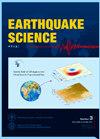Building the 3D seismic fault models for the 2021 MS6.4 Yunnan Yangbi earthquake: The potential role of pre-existing faults in generating unexpected moderate-strong earthquakes in southeast Xizang
IF 1.2
4区 地球科学
Q3 Earth and Planetary Sciences
引用次数: 0
Abstract
The three-dimensional (3D) geometry of a fault is a critical control on earthquake nucleation, dynamic rupture, stress triggering, and related seismic hazards. Therefore, a 3D model of an active fault can significantly improve our understanding of seismogenesis and our ability to evaluate seismic hazards. Utilising the SKUA GoCAD software, we constructed detailed seismic fault models for the 2021 MS6.4 Yangbi earthquake in Yunnan, China, using two sets of relocated earthquake catalogs and focal mechanism solutions following a convenient 3D fault modeling workflow. Our analysis revealed a NW-striking main fault with a high-angle SW dip, accompanied by two branch faults. Interpretation of one dataset revealed a single NNW-striking branch fault SW of the main fault, whereas the other dataset indicated four steep NNE-striking segments with a left-echelon pattern. Additionally, a third ENE-striking short fault was identified NE of the main fault. In combination with the spatial distribution of pre-existing faults, our 3D fault models indicate that the Yangbi earthquake reactivated pre-existing NW- and NE-striking fault directions rather than the surface-exposed Weixi-Qiaohou-Weishan Fault zone. The occurrence of the Yangbi earthquake demonstrates that the reactivation of pre-existing faults away from active fault zones, through either cascade or conjugate rupture modes, can cause unexpected moderate-large earthquakes and severe disasters, necessitating attention in regions like southeast Xizang, which have complex fault systems.
2021年云南阳壁6.4级地震三维地震断层模型的建立:已有断层在西藏东南部产生意外中强地震中的潜在作用
断层的三维几何形状是控制地震成核、动力破裂、应力触发和相关地震灾害的关键因素。因此,活动断层的三维模型可以显著提高我们对地震成因的认识和评估地震危险性的能力。利用SKUA GoCAD软件,利用两套重新定位的地震目录和震源机制解决方案,按照方便的三维断层建模工作流程,构建了2021年中国云南杨壁MS6.4地震的详细地震断层模型。分析表明,北西走向的主断裂具有大角度的西南倾,并伴有两条分支断裂。其中一个数据集的解释显示主断层的西南方向有一条北西向的分支断层,而另一个数据集则显示了4条陡北北向的左梯队构造段。此外,在主断层的东北侧发现了第三条东东短断层。结合已存在断层的空间分布,三维断层模型表明,杨壁地震激活了已存在的北西向和北东向断裂方向,而不是表面暴露的渭西-桥后-渭山断裂带。杨壁地震的发生表明,在远离活动断裂带的情况下,既有断层通过级联破裂或共轭破裂的方式重新激活,可能会引起意外的中大型地震和严重灾害,需要引起西藏东南部等断层系统复杂地区的重视。
本文章由计算机程序翻译,如有差异,请以英文原文为准。
求助全文
约1分钟内获得全文
求助全文
来源期刊

Earthquake Science
GEOCHEMISTRY & GEOPHYSICS-
CiteScore
1.10
自引率
8.30%
发文量
42
审稿时长
3 months
期刊介绍:
Earthquake Science (EQS) aims to publish high-quality, original, peer-reviewed articles on earthquake-related research subjects. It is an English international journal sponsored by the Seismological Society of China and the Institute of Geophysics, China Earthquake Administration.
The topics include, but not limited to, the following
● Seismic sources of all kinds.
● Earth structure at all scales.
● Seismotectonics.
● New methods and theoretical seismology.
● Strong ground motion.
● Seismic phenomena of all kinds.
● Seismic hazards, earthquake forecasting and prediction.
● Seismic instrumentation.
● Significant recent or past seismic events.
● Documentation of recent seismic events or important observations.
● Descriptions of field deployments, new methods, and available software tools.
The types of manuscripts include the following. There is no length requirement, except for the Short Notes.
【Articles】 Original contributions that have not been published elsewhere.
【Short Notes】 Short papers of recent events or topics that warrant rapid peer reviews and publications. Limited to 4 publication pages.
【Rapid Communications】 Significant contributions that warrant rapid peer reviews and publications.
【Review Articles】Review articles are by invitation only. Please contact the editorial office and editors for possible proposals.
【Toolboxes】 Descriptions of novel numerical methods and associated computer codes.
【Data Products】 Documentation of datasets of various kinds that are interested to the community and available for open access (field data, processed data, synthetic data, or models).
【Opinions】Views on important topics and future directions in earthquake science.
【Comments and Replies】Commentaries on a recently published EQS paper is welcome. The authors of the paper commented will be invited to reply. Both the Comment and the Reply are subject to peer review.
 求助内容:
求助内容: 应助结果提醒方式:
应助结果提醒方式:


